Αααααβααα α·αβαα·αβαα αΆααΈαβ
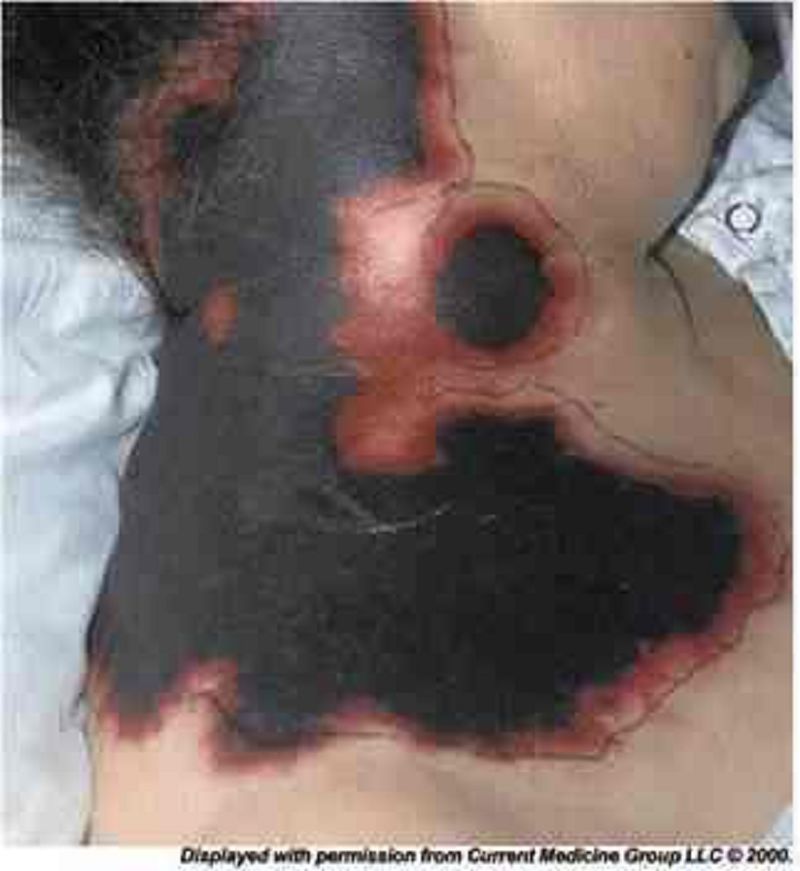
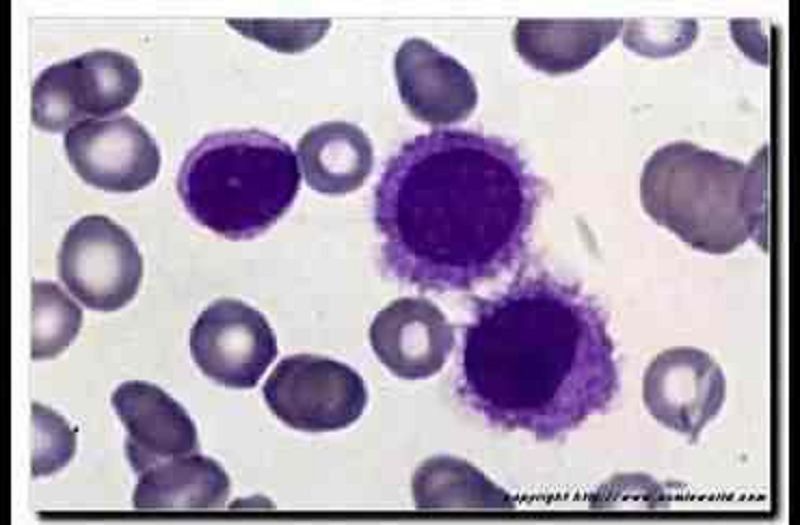
WBC 15,600/mm3
Hemoglobin 17 gm/dl
Hematocrit 52%
Platelets 550,000mm3 RBC count 7.5 million Sodium 141 mEq/L
Potassium 3.6 mEq/L
Bicarbonate 22 mEq/L
Blood urea nitrogen 16 mg/dl Creatinine 0.6 mg/dl
Glucose 95 mg/dl
The erythrocyte indices are all within normal range. What is the most probable diagnosis?
WBC 14,500mm3
Hemoglobin 21.5
Hematocrit 64%, Platelets 521,000mm3 RBC count 7.6 million MCH 30
MCHC 36
MCV 92
ROW 15.1 (n=10.3-14.1)
Which of the following is expected on further work up?
Hb 10.2 g/dl WBC 7,400/cmm Hct 27%
Platelets 4 2,000/mm3
PT 18 sec
INR 2.02
PTT 31 sec
He has no evidence of active bleeding. Which of the following should be administered to this patient at this time?
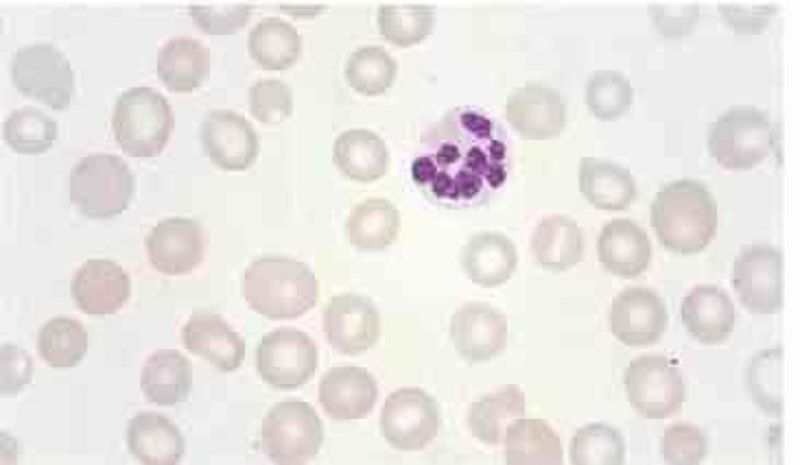
Which of the following substances is most likely elevated in this patient's blood?
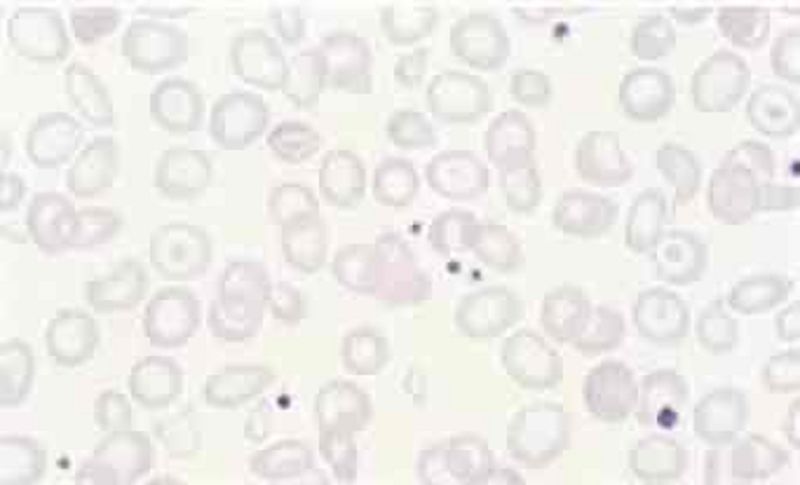
Hemoglobin 10.1 mg/dl RBC count 4.0 x 1012fL MCV 70fl
WBC count 5,500/mm3 Platelets 170,000/mm3 Serum calcium 10.1 mg/dl Serum potassium 4.5 meq/L Serum sodium 135 meq/L
Serial fecal occult blood tests are negative. A peripheral blood smear reveals the following:
Which of the following is the best treatment for this patient?
WBC 66,100/cmm Hemoglobin 8.70
Hematocrit 30%, Platelets 610,000/cmm
The leukocyte distribution on differential smear was Promyelocyte 1%
Myelocyte 8%
Metamyelocyte 15%
Bands 35%
Segmented Neutrophils 25%
Lymphocytes 14%
Monocytes 2%
Further tests are ordered. Which one of the following is expected in this patient?
Hematocrit 20%
WBC count 4,000/micro-L Platelet count 85,000/miro-L Bilirubin 7 mg/dl
Direct bilirubin 1 .2 mg/dl
Serum LDH 500 U/L (normal value is 80-280 U/L)
Serum haptoglobin 20mg/dl (normal value is 30-220 mg/dl)
Peripheral blood smear shows microcytic hypochromic cells. Serum ferritin is low while total iron binding capacity (TIBC) is elevated. Reticulocyte count is 5 %. Urine dipstick testing is positive for hematuria and microscopy of urine shows 1 RBC/HPF. Repeated G6PD assays are normal. Coomb's and micro-Coomb's tests are negative. Bone marrow examination shows hypocellular marrow. Based on these findings, what is the most likely diagnosis?
WBC 7,600mm3
Hemoglobin 8.8 gm/dl
Hematocrit 30%,
RBC count 3.6 million Platelets 211,000mm3 RBC Indices were: MCV 65 fl
MCH 16.5 pg
MCHC 26%
Reticulocyte count 0.5%
Which one of the following is expected on iron studies in this patient? Serum Iron, Ferritin, TIBC, Transferrin Saturation
Hematocrit 20%
WBC count 1 0,000/micro-L Platelet count 180,000/miro-L Total Bilirubin 7 mg/dl
Direct bilirubin 1 A mg/dl BUN 10 mg/dl
Serum creatinine 0.7 mg/dl
Serum LDH 400 U/L (normal value is 80-280 U/L)
Serum haptoglobin 160mg/dl (normal value is 30-220 mg/dl ) Reticulocyte count 8 %
Peripheral blood smear shows spherocytes with central pallor. Osmotic fragility and direct Coombs' tests are positive Based on these findings, what is the most likely diagnosis?
Hemoglobin 13.0 g/dl Serum Ca 8.0 mg/dl BUN 18 mg/dl
Creatinine 1.1 mg/dl
Bone marrow biopsy reveals 2% of plasma lesions. What is the most appropriate next step in the management of this patient?
WBC 11,600 mm3
Hemoglobin 9.6 g/dl
Hematocrit 30%
Platelets 214,000 mm3
Flexible sigmoidoscopy reveals larger areas of ulceration within the colon. What is the best next step in the management of this patient?
WBC 10,200 mm3
Hemoglobin 9.6 g/dl
Hematocrit 29%
Platelets 94,000 mm3
Sodium 141 mEq/L
Potassium 3.6 mEq/L
Blood urea nitrogen 18 mg/dl Creatinine 0.8 mg/dl
Glucose 115 mg/dl
Serum protein electrophoresis reveals an IgM spike.
Which of the following is the most likely diagnosis in this patient?
Hemoglobin 10.0 g/dL
Hematocrit 32% Platelets 126,000/cmm WBC 31,600/cmm Leukocyte distribution
Segmented neutrophils 18%
Lymphocytes 77%
Bands 4%
Monocytes 1%
The pathologist reports the presence of "leukocytes that have undergone partial breakdown during preparation of a stained smear or tissue section, because of their greater fragility." Lymph node biopsy confirms the diagnosis. What is the correct statement about the above patient?
Hemoglobin 11.0 g/dL
Hematocrit 33% Platelets 240,000/mm3 WBC 13,600/mm3
Leukocyte distribution: Segmented neutrophils 76%
Lymphocytes 20%
Bands 2%
Monocytes 2%
RF, ANA, and antibodies to double stranded-DNA are positive in high titers. What is the most likely diagnosis?
Hemoglobin 8.4 mg/dl
Serum iron 30 µg/dL (normal 50- 150 µg/dL)
Total iron binding capacity 230 µg/dL (normal 300-360 µg/dL) Ferritin 300 ng/dl
Which of the following is most likely to improve this patient's anemia?
Hematocrit 59%
WBC count 7,500/mm3 Platelet count 170,000/mm3 ESR 15 mm/hr
Which of the following is the most likely explanation for the high hematocrit in this patient?
Hb 11 .5 g/dL MCV88 fl
Platelet count 50,000/cmm Leukocyte count 7,500/cmm Segmented neutrophils 68%
Bands 1%
Eosinophils 1%
Lymphocytes 24%
Monocytes 6%
Prothrombin time 12 sec (INR=1.0) Partial thromboplastin time 65 sec
His preoperative labs were unremarkable. What is the most likely cause of these findings in this patient?
Erythrocyte count 5 million/mm3 Hemoglobin 14.0 g/dL Leukocyte count 8,000/mm3 Platelet count 80,000/mm3
Which of the following is the best initial test for this patient?
Hemoglobin 8.4 g/dL Leukocyte count 5,500/mm3 Blood urea nitrogen 34 mg/dL Creatinine 2.0 mg/dL
Calcium 10.9 mg/dL
Albumin 3.8 g/dL Total protein 9.5 g/dL
This patient is at increased risk for recurrent infections because of which of the following abnormalities?
VDRL positive FTA-ABS negative Hct 33%
WBC 7,000/mico-L Platelets 70,000/micro-L PT 10 sec
APTT 40 sec
What is the most appropriate next step in the management of this patient?
ESR 15 mm/hr
Hemoglobin 7.5 g/dL
MCV 70 fl
MCHC 29%
Leukocyte count 7,000/cmm Segmented Neutrophils 55%
Bands 3%
Eosinophils 3%
Basophils 0%
Lymphocytes 32%
Monocytes 7%
What is the best next step in the management of this patient?
Hematocrit 59%
WBC count 7,000/mm3 Platelets 200,000/mm3
Which of the following is most likely responsible for this patient's increased hematocrit?
Hemoglobin 9.2 mg/dl
MCV 77 fl
MCHC 30 g/dl
WBC count 7,000/mm3 Platelets 150,000/mm3 Hemoglobin A1c 7.5%
ESR 15 mm/hr
Which of the following is likely to be helpful in improving this patient's symptoms?
WBC 14,000/cmm Hemoglobin 9.9 g/dL
Hematocrit 30% Platelets 100,000/cmm
The lymphocytes have fine, irregular cytoplasmic projections. Cytochemical testing reveals a strong acid phosphatase reaction, which is not inhibited by tartaric acid. What is the most probable diagnosis?
Sodium 137 mEq/dL
Potassium 4.2 mEq/dL
Chloride 101 mEq/dL
Bicarbonate 27 mEq/dL
Calcium 12.0 mg/dl
Phosphorus 2.2 mg/dl
BUN 37 mg/dl
Creatinine 1.8 mg/dl
Which of the following is the most likely diagnosis?
Hemoglobin 7.7 g/dL
MCV 72 fL
MCHC 28%
Leukocyte count 8,000/cmm ESR 15 mm/hr
Serum iron and ferritin levels are decreased. What is the next best step in the management of this patient?
Complete blood count:
Hemoglobin 7.6 g/L
MCV 85 fl
Reticulocytes 8.1% Platelet count 80,000/mm3
Leukocyte count 3,500/mm3 Chemistry panel:
Blood urea nitrogen (BUN) 30 mg/dL Serum creatinine 2.2 mg/dL
Serum calcium 10.0 mg/dL Blood glucose 98 mg/dL Liver studies:
Total bilirubin 3.6 mg/dL Direct bilirubin 1.0 mg/dL Alkaline phosphatase 120 U/L
Aspartate aminotransferase (SGOT) 178 U/L Alanine aminotransferase (SGPT) 255 U/L
Which of the following is the most appropriate next step in the management of this patient?
WBC 6,400 mm3
Hemoglobin 8.7 g/dL
Hematocrit 29% Platelets 193,000mm3 Sodium 144 mEq/L
Potassium 3.6 mEq/L
Bicarbonate 21 mEq/L
Blood urea nitrogen 16 mg/dl Creatinine 0.6 mg/dL
Glucose 245 mg/dL
Which of the following is expected in this patient?
Red blood cells 4.3 million/mm3 Hemoglobin 14.00 g/dL
White blood cells 7,000/cmm Platelets 50,000/cmm
APTT 60 sec (N<25-40 sec)
Fibrin degradation products negative
The emergency head CT scan does not reveal blood in the subarachnoid space or brain parenchyma. Which of the following is the most probable cause of this patient's condition?
Hemoglobin 7.6 mg/dL
MCV 110 fL
MCHC 36 g/dL
WBC count 3,900/mm3 Platelet count 150,000/mm3
This patient should be monitored for which of the following long-term complications?
Erythrocyte count 3.2 mln/mm3 Platelets 60,000/mm3 Leukocyte count 2,500/mm3
Which of the following is the most likely cause of these hematologic findings?
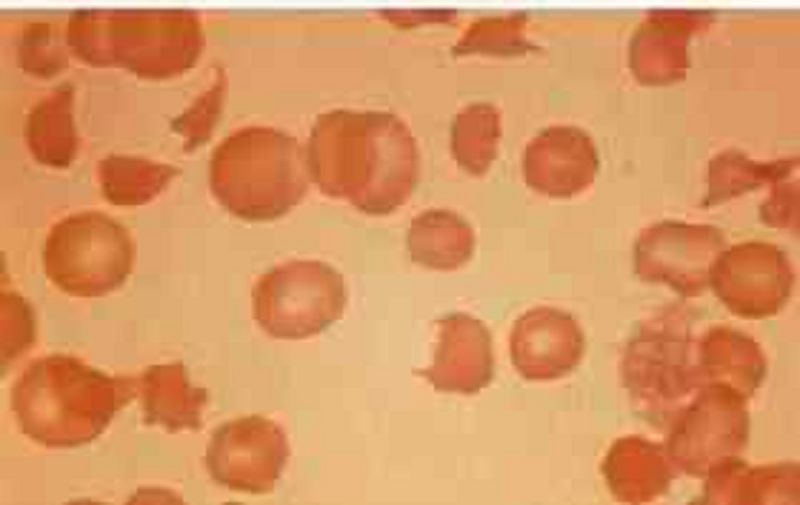
Which of the following laboratory findings would you most expect to find in this patient?
WBC 16,000/cmm with 55% lymphocytes Hemoglobin 13 .5gm/dl
Hematocrit 4 1% Platelets 216,000/cmm
Many variant forms of lymphocytes are seen, including cells with convoluted nuclei and highly vacuolated cytoplasm. Rapid streptococcal throat test, urinalysis, and heterophilic antibody test are all negative. What is the most likely diagnosis?
WBC 81,100 mm3
Hemoglobin 8.0 g/dL
Hematocrit 25%
Platelets 16,000 mm3
Blast forms 80%
Prolymphocytes 10%
Lymphocytes 10%
The blast cells have condensed nuclear chromatin, small nucleoli and scant agranular cytoplasm. Subsequent histochemical staining reveals strongly positive periodic acid Schiff (PAS) reaction. No Auer rods were seen. Which of the following is the most likely diagnosis?
Hemoglobin 7.8 mg/dl RBC count 3.0 x 1012/L MCV 112fl
Platelet count 40,000/mm3
This patient's condition is most likely caused by:
WBC 7,600mm
Hemoglobin 13.6
Hematocrit 40%, Platelets 214,000mm3 Sodium 130 mEq/L
Potassium 3.6 mEq/L
Bicarbonate 18 mEq/L
Blood urea nitrogen 16 mg/dl Creatinine 0.6 mg/dl
Glucose 95 mg/dl
Serum osmolality 260 mOsm/kg (normal 280) Urine osmolality 310 mOsm/kg
A chest x-ray shows a 2-centimeter left upper lobe mass and mediastinal adenopathy. What will be the next best step in management of this patient?
Hb 11.5g/dL MCV 88 fl
Platelet count 160,000/cmm Leukocyte count 7,500/cmm Segmented neutrophils 68%
Bands 1%
Eosinophils 1%
Lymphocytes 24%
Monocytes 6%
Prothrombin time 20 sec (INR=1.9) Partial thromboplastin time 45 sec
WBC 8,600 mm3
Hemoglobin 7.1 g/dl
Hematocrit 25%
Platelets 166,000 mm3
His blood lead levels are elevated. Which of the following is most likely seen in this child's peripheral blood smear?
Hematocrit 60%
WBC count 8,000/mm3 Platelets 180,000/mm3
Which of the following is most likely responsible for this patient's increased hematocrit?
Hemoglobin 7.8 mg/dl
MCV 90 fl
MCHC 33 g/dl
Reticulocytes 7%
WBC count 22,000/mm3 Platelets 200,000/mm3
Complete blood count:
Hemoglobin 84 g/L Platelet count 80,000/mm3
Leukocyte count 5,500/mm3 Chemistry panel
Blood urea nitrogen (BUN) 30 mg/dL Serum creatinine 2.2 mg/dL
Serum calcium 10.0 mg/dL Blood glucose 98 mg/dL
A peripheral blood smear shows many fragmented red blood cells. The prothrombin time is normal. Which of the following is the most appropriate next step in the management of this patient?
CBC:
Hemoglobin 9.8 g/L
MCV 85 fl
Platelets 226,000/mm3 Leukocyte count 6,500/mm3 Neutrophils 60%
Eosinophils 1%
Lymphocytes 29%
Lvlonocytes 10% Chemistry panel:
Serum sodium 138 mEq/L Serum potassium 4.0 mEq/L Bicarbonate 24 mEq/L
Blood urea nitrogen (BUN) 28 mg/dL Serum creatinine 2.1 mg/dL
Calcium 11.2 mg/dL Blood glucose 98 mg/dL Liver studies:
Albumin 4.0 mg/dL
Total protein, serum 9.5 g/dL Total bilirubin 1.0 mg/dL Direct bilirubin 0.8 mg/dL Alkaline phosphatase 110 U/L
Aspartate aminotransferase (SGOT) 58 U/L Alanine aminotransferase (SGPT) 25 U/L
ESR is 100 mm/h. What is the best next step in the management of this patient?
His cousin has SLE but otherwise family history is unremarkable. On ultrasound you suspect testicular cancer and order a few tests. Results are as follows:
Alpha-fetoprotein (AFP) Increased
Beta subunit of the human chorionic gonadotropin (hCG) Normal Placental Alkaline phosphate (PLAP) Normal
Carcinoembryonic antigen (CEA) Slightly Increased Lactate Dehydrogenase (LDH) Increased
What could be the most likely diagnosis?
Sodium 144 mEq/dL
Potassium 4.3 mEq/dL
Chloride 98 mEq/dL
Bicarbonate 21 mEq/dL
Calcium 14.5 mg/dl
BUN 48 mg/dl
Creatinine 2.0 mg/dl
Chest x-ray hilar mass in the left lung
While in the ED, he becomes more somnolent and vomits twice. What is the best next step in the management of this patient?
His vital signs are, BP: 122/80 mm Hg, PR 80/min, RR 16/min and Temperature 37C (98F). What is the most appropriate next step in management of this patient?

Sodium 144 mEq/dL
Potassium 4.3 mEq/dL
Chloride 98 mEq/dL
Bicarbonate 21 mEq/dL
Calcium 11.5 mg/dl
BUN 28 mg/dl
Creatinine 0.8 mg/dl